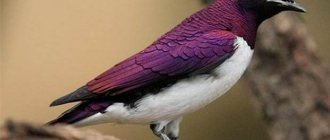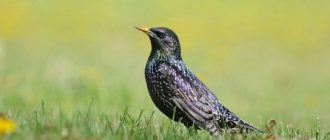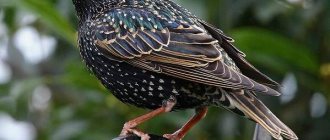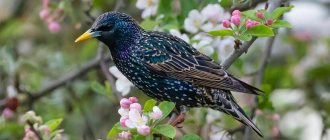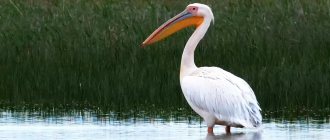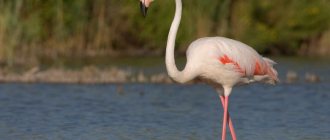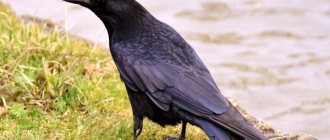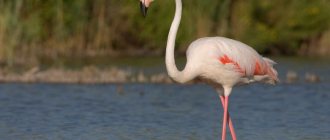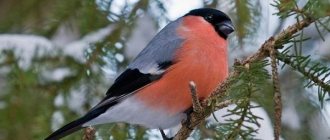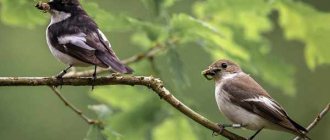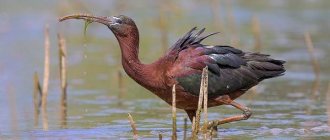In the starling family there is a special type of highly social creatures - pink starling . It is rare to see a single bird; they live in groups of tens or even hundreds of individuals. In flight they look like an unusual pink cloud. Although the birds are close relatives of common starlings, they differ in their special character and way of life.
Description and features
The name of the bird reflects the main feature - the pastel pink color of the plumage of the chest, abdomen, sides, and back. A contrasting black color with a metallic sheen covers the starling's head, entire neck, upper chest, wings, and tail.
A greenish-purple tint appears on the flight and tail feathers. After molting in the fall, the color of the birds appears gray on black, sandy on pink. The plumage style is often compared to the crow, only it has a black and gray color scheme.
The pink starling in the photo looks like a badass. On the back of the head, elongated feathers form a funny crest, more pronounced in the male. The tail is short. The beak of the pink representative of its relatives is thicker and shorter than that of the ordinary species.
Its color changes from dark pink in winter and spring to black-brown in summer and autumn. The shape of the beak is pointed. The appearance of males is brighter than that of females. Young birds do not shine with colors - the plumage is gray-brown at the top, sandy at the bottom.
The size of adult birds is the same as that of other starlings - the body is 19-25 cm, the wingspan is about 14 cm, the weight of an individual is up to 90 grams.
The Rosy Starling is known to be a social bird due to its giant flocks. Huge communities form gigantic colonies. In the summer, hundreds of starlings move and feed in large flocks and spend the night in separate groups.
- 34 facts about raccoons
- Maned wolf
- Nettle
- Elk
- 100 facts about bears
- Jungle animals
In winter, communities include tens of thousands of individuals, sometimes mixed with other birds: crows, sparrows, necklace parrots. There is no aggression between them.
Compared to ordinary starlings, pink birds are very mobile, covering considerable distances, returning to their original places. In flight, due to frequent flapping of the wings, they develop high speed.
In habits, like relatives of pink starlings, they run with nodding heads, scattered on the ground, in search of food.
Bird hunting is organized. The bird cloud, as if in ranks, moves in one direction, snatching prey from the grass stand: locusts and grasshoppers. The distance between the birds is approximately 10 cm. There is enough food for everyone, including young offspring. Friendly companies, as if on command, move to a new place.
References
- ^ a b BirdLife International (2004). "Sturnus roseus" IUCN Red List of Threatened Species
.
2004
. Retrieved May 12, 2006. URL in old form - Gilman, D.C.; Peck, H. T.; Colby, F. M., ed. (1905). "Pastor". New International Encyclopedia
(1st ed.). New York: Dodd, Mead. - Jonsson, Knud A. & Fjeldså, John (2006): Phylogenetic supertree of oscine passerines (Aves: Passeri). Zool. Scripta 35
(2):149–186. DOI: 10.1111/j.1463-6409.2006.00221.x - ^ ab Jobling, James A. (2010). Helm's Dictionary of Scientific Names for Birds. London: Christopher Helm. pp. 294, 337. ISBN 978-1-4081-2501-4.
- "Pastor". Oxford English Dictionary
(Online ed.). Oxford University Press. (Subscription or membership at a participating institution is required.) - "Oriolus traillii - Avibase". avibase.bsc-eoc.org
. Retrieved March 1, 2022. - ^ ab Rasmussen, Pamela S.; Anderton, John S. (2005). Birds of South Asia Ripley's Guide
(First Edition). Washington, DC: NMNH, Lynx Editions. pp. 582–583. ISBN 84-87334-66-0. - CCTV
- Ali, Salim; Ripley, S. Dillon (1987). Handbook of the Birds of India and Pakistan
(second ed.). New Delhi: Oxford University Press. pp. 163–166. ISBN 978-0-19-565938-2.
Habitat
These birds are widespread in the countries of Central Asia and South-Eastern Europe. On the territory of Russia and the former countries of the USSR, the range of pink starlings is the northern part of Siberia, the Caucasus and Transcaucasia, Kazakhstan, and the western regions of Ukraine. However, every year they fly to Asia for the winter: India or Ceylon. Some of their species migrate to the south of Europe, others fly to North America.
These are social birds that nest and live in large colonies, which can reach several hundred individuals in the summer season.
They return from wintering in large flocks, roosting in groups for the night, clinging to their neighbors. They arrive at nesting sites in April, forming flocks of several thousand pairs. Sometimes they flock with other small birds (sparrows, crows, etc.).
Starlings fly at high speed in large flocks, being close to each other, so they form huge “gray clouds” in the sky, which looks very impressive (as can be seen in the photo of pink starlings flying over the trees).
Every day they go to the steppe to feed, sometimes dividing into several groups. Seeing the prey, they immediately descend to the ground in the entire flock and attack the moving waves of locusts. Moreover, the latter, having taken off above the flock, fly forward, so the “cloud” seems to roll in waves.
When in danger, birds gather in large communities and drive away enemies with loud warlike cries. They are known for their fighting spirit when they evict other birds from occupied nesting boxes.
Distribution and habitats
The habitat of the pink starling occupies the steppe and semi-desert zones of South-Eastern Europe, South-West Siberia, Central and Western Asia. The nesting area varies seasonally depending on the abundance of food supply. They nest in colonies; nests are made in rocks, on steep banks of reservoirs, near humans - in artificial birdhouses or buildings with niches. There must be water near colonies of pink starlings.
Reproduction
In Central Asia, the nesting season begins from mid-April to the first ten days of May, and in Southern Europe from the second half of May to mid-June. Representatives of this species become sexually mature at the age of one year.
The pink starling places its nest in tree hollows, rock crevices, wall cracks and under the roofs of houses. Breeding colonies can sometimes consist of several thousand breeding pairs.
The nest is constructed from twigs, leaves and roots. The inside is lined with feathers, moss and animal hair. Sprigs of wormwood (Artemisia absinthium) and ferula communis (Ferula communis) are often added to it, which repel parasites.
A married couple may use the same nest for many years. The female lays 3 to 6 bluish eggs measuring 25-33 by 19-23 mm. The clutch is incubated alternately by both parents for 14-16 days. They feed the hatched chicks exclusively with insects and their larvae. At three weeks old, the chicks begin to fledge, but continue to be dependent on their parents for about 2 more weeks, gradually transitioning to independent existence.
Juveniles look like common starlings (Sturnus vulgaris), but are distinguished by a shorter yellowish bill and lighter underparts in relation to the dark wings.
Starling nests
Pink starlings make nests in rock crevices and fragments of cliffs, between stones, in burrows built by swallows, in cracks on cliffs. In the steppes, nests are built in depressions in the ground.
The bird's nest is formed from a thin layer of dry plant stems. A careless layer of stems is covered with wormwood leaves, feathers dropped by steppe birds. When finished, the nests look like massive small bowls. The top of the nest is barely covered with sparse grass or pebbles.
On an area of 25 m2, pink starlings manage to place up to 20 nests. The nests are crowded one next to another, sometimes touching the walls. From the outside, at first glance, it seems that it is just a chaotic heap of garbage. With such careless construction, the masonry becomes prey for voracious locusts.
Pale gray eggs appear in nests in May. A full clutch contains 4-7 eggs. The chicks, born after 5 weeks in an atmosphere of crowding and complete confusion, become the common property of all adults. Couples who have lost their offspring due to locusts cope painlessly with the loss by feeding other people's chicks.
Grown-up chicks do not shy away from their adult counterparts. They willingly take over the food of any nearby bird. In a kingdom of incessant crowds and confusion, adult birds indiscriminately distribute food, satisfying the hunger of their own and neighboring young birds.
Nutrition and feeding behavior
During the nesting period, pink starlings feed almost exclusively on animal food, mainly orthopteran insects (locusts). According to ornithologists, the diet of the pink starling in May-July consists of 70-100% animal food, with orthoptera insects accounting for up to 62%. It is known that the pink starling eats about 200 insects per day, i.e. 2.5 times more than it weighs itself. He feeds the same amount to the chicks. Therefore, the number of insects destroyed by a flock of pink starlings can be quite significant, and pink starlings themselves are considered one of the most useful birds. The benefit is also increased because starlings know in advance where there will be a concentration of insects, and it is there that they arrange their nesting colonies.
Starlings feed in places where locusts accumulate, mainly on the ground. There are no fights for prey among them; rather, on the contrary, individuals who have found prey call other members of the pack to hunt it down. Having caught a locust (or a large grasshopper), the starling first tears off its limbs and wings, then hits the ground and only then eats it. There are observations that starlings that have already eaten their fill still continue to catch and kill insects.
During non-breeding times, plant foods begin to play a large role in the diet of starlings, and then wandering flocks can attack gardens and vineyards.
Benefits and harms of pink starlings
The pink starling is beneficial to humans, destroying a large number of insects for its food and feeding its chicks. In a day, one small bird can catch and eat about 200 different large and small insects, and each parent catches the same number for their younger generation.
Most often, starlings eat ants, caterpillars, beetles, cicadas, butterflies and even snails. The bird's favorite delicacy is locusts, which the bird tears off its legs and wings, then hits it on the ground to soften it and swallows it. For this, he is loved and revered by all local gardeners and farmers, for whom the locust is a pest that devours useful plants and seedlings.
Starlings often fly in flocks when they detect clusters of insects, which they destroy to the last beetle or ant. According to historical observations of biologists, it was they who saved the crops in Kazakhstan in 1944-45, when the steppes were flooded with billions of breeding locusts, which the extermination measures and chemical insecticides could not completely cope with.
However, in some countries, especially closer to autumn when switching to plant food, these birds cause damage to orchards, vineyards, and mulberry trees. Thus, in India, pink starlings can damage and devastate rice fields. Winemakers save their plantings using home methods: wooden rattles, metal rattling sheets, basins, and watchtowers are often placed in the vineyards to monitor the activity of starlings.
However, the benefit of these birds in destroying locusts many times exceeds the damage from eating berries and plants.
Harmful or beneficial
During the ripening period, wandering starlings turn into a real disaster for gardeners. Therefore, a logical question arises about whether it is necessary to reduce the number of the pink starling, which is characterized by excessive gluttony. Does the benefit brought by the destruction of pests during their mass development compensate for the damage caused to the crop in the gardens?
To answer this question, you need to make some simple calculations. In captivity, the bird can eat up to 300 harmful insects. A colony of one and a half thousand pairs will destroy approximately a million harmful creatures within 24 hours.
In addition, pink starlings settle in huge colonies only where pests breed en masse. At the same time, birds know in advance about the danger, which people are able to notice only when it becomes obvious. Considering that locusts destroy everything without regret, starlings become a real salvation for the crop. The harm caused by birds simply pales in comparison to the disaster caused by locusts.
Starling Singers
Like some of its relatives, pink starlings perfectly copy sounds: the voices of other birds (crows, hens or sparrows), dog barking, frog croaking, etc. They often try to imitate people whistling, car horns, and other original sounds. Birds arriving from Asian countries can repeat the voices of birds of the subtropics, and those who visited the Kazakhstan steppes can imitate the bleating of sheep, the barking of dogs and even the cracking of a whip.
The very singing of starlings does not at all resemble a melody, but rather a squealing or grinding sound.
Shpak is a close relative of the pink starling
The starling family has about 40 species. Most of them have a sharp, straight beak and live in Asia, Africa and Europe. To the question of who is the relative of the pink starling, any schoolchild can answer: this is an ordinary starling or shpak, distributed throughout Europe and Russia, as well as North America, Australia and New Zealand.
It differs from the pink bird in its gray-black color with white spots and a yellow beak, habitats and diet (plant and animal). Unlike their pink counterparts, shpakis live in small groups of several pairs. They settle in deciduous forests (they love oak forests) near water and small fields or meadows. They make nests in tree hollows and often live in cities near people in birdhouses or dovecotes.
Kinds
The genus of starlings includes more than 10 species of birds with similar lifestyles. The pink starling is one of them. It is sometimes confused with a close genus of the Brahman relative, which is distinguished by a light brown color with a reddish tint, patches of skin without feathers behind the eyes and more rounded wings.
Both species are similar in lifestyle, but the Brahman relative can more often be seen near human habitation.
Signs associated with starlings
Starlings are very common in nature, and people have long come up with various proverbs and noticed signs that are associated with their behavior:
- the starling has arrived - spring is coming;
- if the birds arrived early, then spring will be warm;
- when they don’t fly away for the winter for a long time, the autumn will be dry;
- after the loud chirping there will be rain at night.
Almost all types of starlings, incl. and pink ones that live next to a person have their own unique character.
Sacred birds
Since ancient times, Asian peoples have revered pink starlings as sacred birds. Their deification, as well as some religious cults common among Asian tribes, created for them the fame of “children of the air.”
This was due to invasions of locusts, which in the steppes always destroyed most of the crops of farmers and nomads. People could not fight this pest, because then there were no chemicals and insecticides that are now used in agriculture. Therefore, locust invasions doomed entire settlements to hunger and poverty. Whole clouds of birds with pink and black plumage suddenly swooping in and destroyed the locusts almost completely, thus saving people.
That’s why starlings are considered messengers of good gods who help people.
